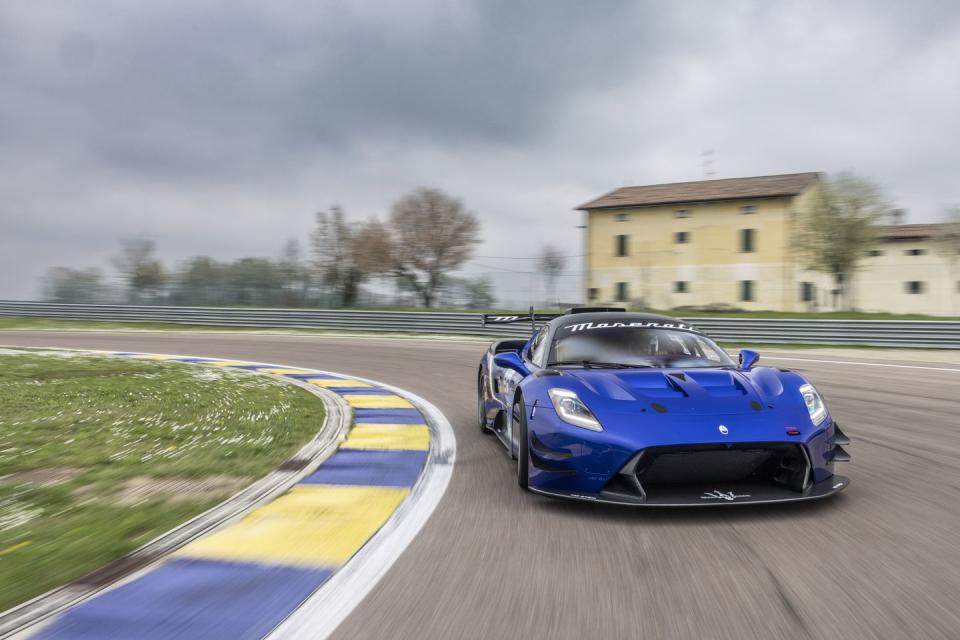Maserati's GT2 Race Car Will Be Your Best Friend
From the moment we laid eyes on the Maserati MC20's striking curves, we couldn't help but imagine a more aggressive version. After some seat time, thoughts of a street-legal track machine competing with the downforce behemoths from Chevrolet and Porsche raced through our heads. Maserati clearly had similar thoughts but instead skipped the road-ready version and went right to track-only mode. After all, before the latest iterations of Corvette Z06 and Porsche 911 GT3 RS came to be, the C8.R and 911 R traded paint on the track.
Maserati won't say if a similar trajectory is in the cards, but since then, they've created the MCXtrema, a rolling work of aerodynamic art exclusively for track use. Now, with a few elements borrowed from the MCXtrema, we have the aptly named GT2—successor to the MC12 race car and homologated to go racing in the Fanatec GT2 European Series.
Not Just an MC20 with Extra Aero
The GT2 begins life on the same production line as the MC20 before being pulled aside and massaged for track duty. The intent of returning to racing weighed heavily in Maserati's decision to fit the MC20 with a carbon-fiber monocoque, which required only slight modification to incorporate the GT2's FIA-approved roll cage. Very few body pieces are shared between the MC20 and the GT2, save for some bits of the door, the headlights, and the taillights. The front bumper and splitter assembly, louvered hood, engine cover, rear bumper, and diffuser all have latches for hasty removal, in case of any on-track incidents. Holes in the carbon-fiber-reinforced-plastic body panels feed air to the brakes and various coolers. The roof snorkel delivers a steady breeze to the engine and transmission coolers. Intercoolers from the production MC20 live within the GT2's hindquarters, and because the engineers get their way when it's race time, they're mounted a bit more upright here.
Nestled under the GT2's engine cover is the same Nettuno twin-turbocharged 3.0-liter V-6 that powers the MC20. Maserati claims the engine is about 80 percent the same as the street car, sans GT2-specific exhaust manifolds and larger turbochargers plucked from the MCXtrema. Despite the larger turbos, the GT2 won't outdo the MCXtrema's 724-hp rating. In its most aggressive engine mapping, the 3.0-liter produces the same 621 horsepower as the street car. So, why the bigger turbos? The engineers say the new snails help with tuning when balance-of-performance rules inevitably force Maserati to dial back the power in order for the pack to stay competitive. The GT2's motive force is sent to the rear wheels through a HÖR Technologie six-speed sequential racing transmission and an adjustable limited-slip rear differential.

The Nettuno's prechamber ignition and two spark plugs per cylinder remain in place for the GT2. Fuel economy in the GT2 European Series isn't critical, but with the possibility of endurance racing in the future, Maserati hopes the trick combustion process allows it to calibrate an engine map capable of stretching a gallon of fuel further than the competition can.
On the suspension front, beefy billet-aluminum unequal-length control arms reside at all four corners—whereas the street MC20 utilizes a multilink setup. You won't find any pliant rubber in this configuration; the arms attach to the body via rigid ball joints. Öhlins coil-over dampers feature adjustable compression and rebound, and both anti-roll bars offer three adjustment positions.
Track Time
Foreign tracks and unfamiliar cars—prototype versions, at that—can deliver an overload of anxiety. Since nobody likes flying blind, we strapped into the passenger seat alongside decorated racer and Maserati reference driver Andrea Bertolini for some familiarity laps of Autodromo di Modena's 1.3-mile configuration before being given the opportunity to thrash the GT2 ourselves.

Thanks to the MC20's butterfly-style doors, it's one of the easiest supercars to enter and exit. Much of that feeling carries over into the GT2; just get a leg through the roll cage and slide into the Sabelt fixed bucket seat. Once you're settled in, all the controls and buttons on the steering yoke and center console are intuitive and clearly labeled. On the latter, any buttons with related functions are in the same row and given the same color—lights are green, rain-related controls are blue, and so on. Should one option the GT2 with air conditioning and a passenger seat, the brave soul riding shotgun gets their own vent and fan control. The engine's vitals and just about any other sensor's data can be displayed on the Bosch digital instrument cluster.
With the pedal box adjusted and the six-point belts pulled tight, we turn on the fuel pump that audibly whirls its way to life. With the ignition switch flipped on and the clutch depressed, the V-6 crackles to life. A race engineer gives the thumbs-up. The GT2 drops off the air jacks. It's go time.
We ease off the clutch, and the GT2 exits the pit box with the mechanical orchestra of a race car. All the drivetrain's whoop-whoot-whoops and weee-we-weeees echo through the cockpit. To keep the tires at the right temperature, the out lap needs to be tackled with mild aggression. Every gearshift activates the air pump that feeds the gearbox. It always sounds broken. Race car noises are fun.

As the GT2 accelerates up to 135 mph on Autodromo di Modena's front straight, each gearshift is immediate. Respecting the braking zone and still sussing everything out, we stand on the center pedal sooner than normal. There's a lot of travel underfoot and there isn't much feel to it—or, for that matter, any indication the 11-position-adjustable anti-lock-braking system is doing anything. But as the laps accumulate and the brakes and Pirelli P Zero race slicks reach a proper operating zone, the 15.4-inch iron rotors and six-piston calipers up front and 14.0-inch, four-piston units in the rear really start to show their force. Brake bias is easily adjusted with a big knob to the right of the driver's seat. Bertolini has the brake bias set so roughly 60 percent of the force applies itself rearward, and it feels just right to us. We might like a firmer pedal, but it's easy to adapt to and modulate the setup as-is.
Entering Turn 1, the steering is seriously quick with a tremendous amount of feel and feedback. The electronically assisted steering rack even offers five settings of assistance, controlled by a dial on the center console. Initially, the Pirellis deliver massive amounts of grip, but if a driver pushes just a touch too hard, understeer arrives and is transmitted through the yoke instantaneously. As the lateral bite goes away, it doesn't feel like a leap off a cliff, but rather a linear buildup to that event. If only street cars drove like this.

Turns 2 and 3 comprise a slower left-right section. Admittedly, we're probably being too timid with the throttle application. However, even with the three engine maps set to their most powerful positions and the six-position traction-control dial set to one of the less intrusive settings, the rear tires are hooked up. Taking big stabs at the throttle doesn't throw the tail out, but it will send terrific turbo whoosh and wastegate-purge sounds into the cockpit.
Flying down the back straight, the straight-piped V-6's soundtrack is basically the only reminder you're in something that was briefly an MC20. Whereas the V-12-motivated MC12 was a symphony, the GT2's twin-turbo six is more of a thrash-metal concert. It's not bad, just different.
There's a slight hump over a blind crest where the track's configurations intersect. In the MC20, that spot is enough to upset the traction control as the car gets light on its feet at full throttle. The GT2 and its downforce-generating dive planes, three-position adjustable front splitter, and 10-position rear wing force the Pirellis into the tarmac, and the GT2 feels unflappable.

The final portion of this brief circuit awards patience. In these slower corners, if there's any body roll, it would take medical-grade instrumentation to detect it. After just a dozen laps, we already feel at home in the GT2. The fact that this car is so approachable and so much easier to drive quickly than an MC20 is exactly how Maserati intended it to be. They've built a race car that even a mildly experienced driver will feel comfortable in.
When the GT2 competes in its first full season of the Fanatec series, five customer cars are set to line up on the grid. For those not interested in traveling to Europe to race, Maserati will deliver a car to the United States for $522,000 to use for track days. That's a lot of coin, but to stand out among the hordes of 911s and Corvettes, and given how approachable the GT2 is for drivers of all kinds, there are certainly far worse ways to spend it.
You Might Also Like

 Yahoo Autos
Yahoo Autos 